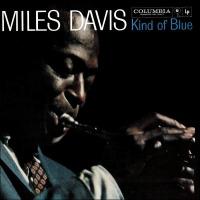A Digital Kind of Blue?
More than enough has been written about this album for me to attempt to add anything of value to the mix. It's the best selling jazz album ever and continues to sell the way Pink Floyd's Dark Side of the Moon does in the rock world.
If you know and love the record you owe it to yourself to read Ashley Kahn's essential "Kind of Blue-The Making of the Miles Davis Masterpiece" published in paperback by Granta (www.granta.com).
More than enough has been written about this album for me to attempt to add anything of value to the mix. It's the best selling jazz album ever and continues to sell the way Pink Floyd's Dark Side of the Moon does in the rock world.
If you know and love the record you owe it to yourself to read Ashley Kahn's essential "Kind of Blue-The Making of the Miles Davis Masterpiece" published in paperback by Granta (www.granta.com).
As many of you know, Classic Records issued this on 180g then 200g and then as a single-sided 45rpm set all cut by Bernie Grundman. The Classic reissue included the original album as first issued in 1959 that has the three tunes on side A at the wrong pitch (too fast) because one of the tape recorders was running about an eighth tone (1 1/4%) too slow during the recording session. A second LP in the set included side A at the correct speed on one side and an alternate version of "Flamenco Sketches" (the only surviving complete alternate take from the original sessions) on the other.
Classic's reasoning was that reissuing side one at the wrong speed was the authentic reissue of the "original."And of course they didn't correct the egregious incorrect spelling of Cannonball Adderley's last name as "Adderly"—a mistake that has followed the sax great's name in print and on line forever after. Meanwhile, Classic Records has been sold to Acoustic Sounds and the license to press KOB has expired, though some copies are still around.
In 2009 to celebrate the album's 50th anniversary, Sony Music decided to reissue the album newly mastered from the same original 3 track master Classic had used, both on CD and blue vinyl as part of a box set containing a book and other supplementals. That set can still be found online in in some stores.
The lacquers were cut (speed corrected) from the 3-track original tape by George Marino at Sterling Sound and plated and pressed on 180g blue vinyl either at Rainbo in California or at United in Nashville (I can't remember which). Unfortunately, virtually every copy pressed was horrendously noisy for the first ten minutes or so (at least) due, probably to "non-fill" that occurs when the vinyl begins to harden before it's squeezed outward fully and the plate's ridges can create a clean groove.
What a shame!
However, at the same time the lacquer was cut, Marino created a 96k/24 bit file from which the set's CD was produced. That file was used by Music on Vinyl, a European company that some years ago bought Sony's Holland-based vinyl pressing plant.
This two LP set is also pressed on blue vinyl. The first album is the KOB we all know and love but speed corrected, while the second LP has the alternative version of "Flamenco Sketches" on one side and a version of "On Green Dolphin Street" recorded prior to the KOB sessions featuring the Evans, Coltrane, Chambers and Cobb lineup.
The two LP set is a limited to 3000 edition packaged in a gatefold jacket with the original cover and back cover on the first half and a short Francis Davis essay accompanied by some session photos on the right inside and a shot of Davis on the back of the jacket graphically interpreted plus the track listing.
It's a very nicely put together package though the red ring around the outside of the "6 Eye" label robs it of graphic authenticity. More importantly, Music on Vinyl's plating and pressing are outstanding. The records are dead silent and the transparent sense of reaching back into the studio is complete, despite the digital source.
Is the sound identical to Classic's all-analogue reissue? I compared Classic's speed-corrected side C with Music on Vinyl's side 1 and they were not indentical but even hardened digiphobes might be surprised by what they hear and which they prefer.
Yes, the digitally sourced LP is slightly and I mean very slightly drier but there's still plenty of 30th Street Studio ambience to be heard and a good deal of air around Miles' horn. Some front to back depth is lost, but not much. What's gained though is a surprising amount of detail in Jimmy Cobb's drumming. Maybe it's not fair to say more detail so let's just say a different perspective is shed on the percussive proceedings.
The horns are also a bit "meatier" and less ethereal. Is this due to the digitization or simply the sonic differences between Grundman's and Marino's mastering chains? I don't know nor do I think it matters—that's how subtle are the differences. Which you might prefer could be surprising.
A comparison between a quiet original blue AAA reissue and this one might be interesting if such a pressing could be found, but even then differences in cutting and plating would interfere with making a comparison meaningful.
So if you want a copy of KOB and can't find the Classic, I'd say don't worry about the digits being involved in this reissue. It sounds great.
That said, be sure not to compare any of these reissues to a clean, quiet, minty original. Time has robbed the tapes of their ultra-high frequencies and there's nothing anyone can do about that. But try finding an original that provides the velvety smooth black backgrounds any of the well pressed reissues provide.
More trade-offs.




